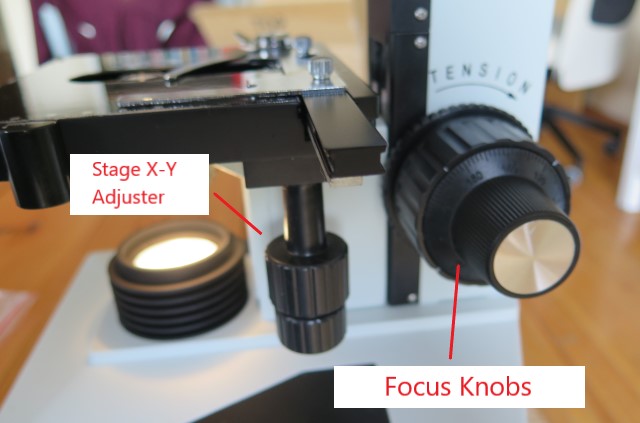
The base on a microscope provides support and stability for the various components of the microscope, including the arm, illuminator, and stage.
The main purpose of the base is to provide stability.
It also usually has knobs on it that help with the operation of the microscope. These include the fine and coarse focus knobs, the dimmer, and the mechanical stage adjuster.
What Is the Function of the Base on a Microscope?
The base of a microscope provides necessary support for all of the other components so that the microscope can be operated efficiently and effectively.
At its simplest level, it stops the microscope from wobbling while it’s being used or falling over.
The base also houses the stage and illuminator, both of which are essential components to accurate find and contrast a specimen.
The base on a microscope also attaches to the arm, which provides support for the components over the stage including the head, nosepiece, objectives, eyepiece, and eyepiece tube.
It is also usually where various dials on a microscope are, including:
- Fine and Coarse Focus Knobs: These are the knobs that can bring the sample under the microscope into focus. The coarse focus knob can change the focus rapidly, while the fine focus knob moves in smaller increments and is used to get the focus absolutely perfect.
- Dimmer: The dimmer helps increase and decrease the intensity of the substage illuminator that sits in the base (and below the stage).
- Iris Diaphragm Dial: There may also be a dial to allow you to open and close the iris diaphragm, which also helps to get the substage lighting perfect for viewing a specimen.
- Mechanical Stage Adjuster: If your microscope has a mechanical stage, the mechanical stage adjuster will be found on the base of the microscope. It should have both an X and Y axis adjuster so you can move the stage around to get the specimen in the perfect location for viewing.
What Are the Knobs on the Base of a Microscope?
The two most common knobs on the base of a microscope are the coarse and fine focus adjusters. Their function is to adjust the lens to focus on the specimen on the stage.
Depending on the quality of the microscope, it might only have a course focus knob. Higher quality microscopes will feature both a course and fine focus knob.
The coarse focus knob moves the stage to get a rough approximation of the distance. Then, the fine focus knob is used to improve the focus more.
Why Do Microscopes Have an Illuminator in the Base?
The illuminator is built into the base of a microscope, and its role is to provide high-intensity light to the area under the lens.
Different optical lenses are calibrated to control the degree of illumination, and the illuminator can even provide additional color enhancement.
The features of the illuminator will vary by model of microscope, with higher-end microscopes having a wider range of functions to improve the level of image contrast and lens focus, while lower-end microscopes may only have a coarse focus adjuster and a switch to turn the illuminator on and off..
What Is the Stage Plate on a Microscope?
The stage plate on a microscope has one simple function: to hold the specimen for examination.
Stages are platforms fixed in place with a hole above the illuminator and under the objective lens.
The stage may also have clips for holding the specimen in place, called stage clips.
Mechanical stages allow you to move the stage so the operator has more fine-tuned control in moving the specimen. Generally, a mechanical stage is ideal for magnifications of 400x or greater.
On a standard stage, slight movements would cause the specimen to exit the field of view. Stage plates are used on stereo microscopes and uses a circular hole in the base of the scope to hold a plastic disk or frosted glass plate.
These provide superior contrast lighting for better examination of the specimen.
What Are the Clips on the Base of a Microscope?
The clips on the base of the microscope serve a simple, yet important purpose. They clip onto the side of the slides and hold the slide in place.
These clips are usually spring-loaded to help lock the edges of the slide in place.
Stage clips are generally used for low magnification since you have a larger field of view and it’s easier to see the target object.
At higher magnification, relocating the field of view proves impractical. That’s where the mechanical stage proves useful once again with a stage controller that can accurately pinpoint the slide and manipulate it at high magnification.
Conclusion
A microscope has many precise components that are designed to facilitate its use and help the operator see the specimen for examination more clearly. The base is a crucial component because it keeps all of the other parts stable and keeps the microscope still while it’s being used.
Other components like the illuminator and the focus knobs help to provide clarify and contrast to the image for easier viewing, while the stage clips and stage plate are instrumental in holding the specimen and narrowing down the field of view.

Hi, I’m Chris and I run things around here! I share all my microscopy experiments, microscope information and tricks, how to guides, and microscope reviews in the articles on this site. Browse around to see what you like (I recommend the experiment ideas section) or connect with me on any of the social platforms listed below.
